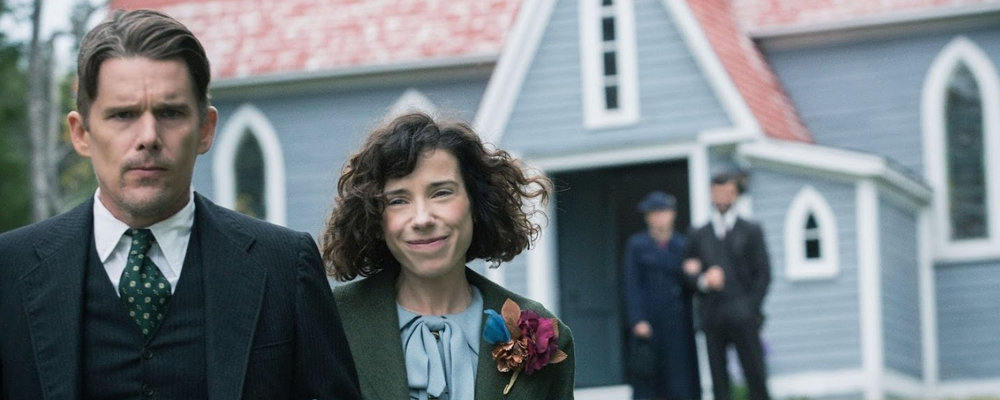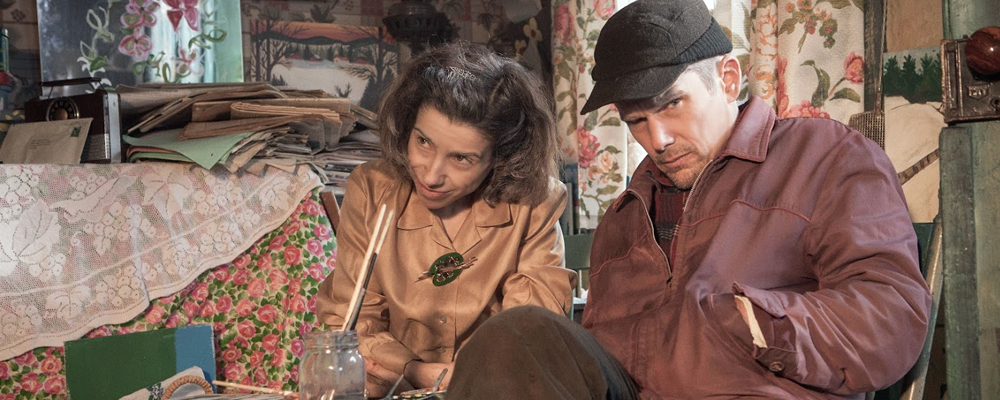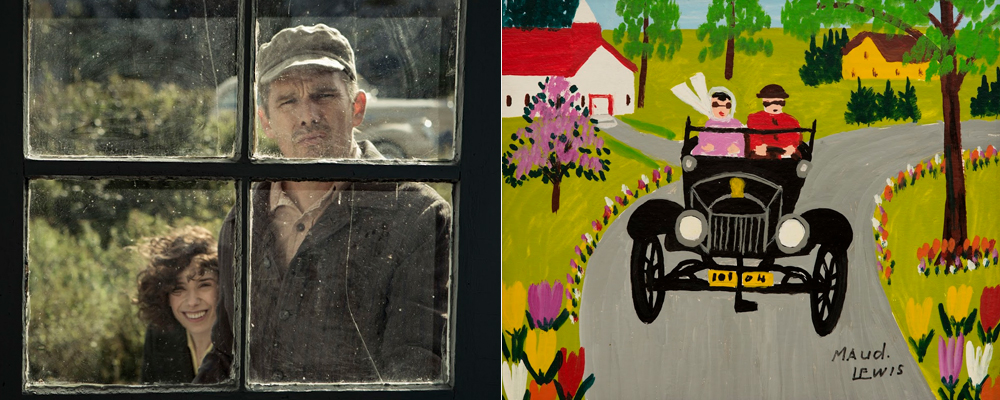Director Aisling Walsh Talks Recreating the World of Artist Maud Lewis in ‘Maudie’
Sandra Miska
In the biopic “Maudie,” Sally Hawkins wows as Maud Lewis (1903-1970), a Canadian folk artist who teaches herself to paint despite suffering from arthritis and dealing with a myriad of other obstacles. What makes her story even more incredible is that she does all this living in a 12-by-12 foot house in rural Nova Scotia under conditions that we today would describe as “off the grid.” Maud isn’t alone in this house, as she lives there for 35 years with her husband Everett, a gruff fish peddler played by Ethan Hawke, who, like Hawkins, gives one of the best performances of his career. The film’s story begins with Maud, then 34, answering an ad Everett, a 40-year-old bachelor, posts at a local general store looking for a live-in housekeeper. While most women would have turned around and run away upon entering Everett’s dingy home, Maud stays, eventually marrying Everett and turning their home into a work of art. She also slowly changes the man himself, who is introduced as an uncouth loner who prefers the company of dogs to people.
Despite a new living situation that many would see as restrictive, Maud’s position represents freedom, as she is no longer dependent on her overbearing aunt (Gabrielle Rose) and selfish brother (Zachary Bennett). She blossoms as an artist after taking Everett’s order to make the house prettier to heart by painting on the walls, and it’s not long before their cozy home doubles as her studio in which she creates art that she sells first to locals and eventually people from all over the world, including Richard Nixon.
“There’s a lot of talk at the moment about women having their careers and doing what they want to do. She struggled to do what she wanted to do, but she did it, despite everything,” says director Aisling Walsh, who herself trained as a painter in her native Ireland before moving to England to study film. Walsh sat down with “Entertainment Voice” on the rooftop of The London West Hollywood to speak about Maud and her journey in bringing her story to life.
The fact that Maud was a painter was one of the major reasons Walsh was drawn to Sherry White’s screenplay. “I think that really struck something with me. I wanted to make another film about a painter, actually, for quite a while. I just felt this would be a fantastic opportunity. And, also, her art is very naïve. She was a woman, she was an artist, she struggled, that, first of all [attracted me]. And it is not very often you see a film that is a portrait of a marriage that lasts over 35 years. I loved that about it, too, that it is this rather unusual love story where these two odd outsiders meet up and you can’t imagine that they’re going to be together at the end of the film, and it’s a lovely portrait of a relationship and a marriage that you don’t see very often on film.”
The conditions that Maud lived under also fascinated Walsh. “[She dealt with] weather that went from days like this [warm and sunny] to minus 25 in the snow in those sort of brutal winters that they have there. What surprised me was she just had the most positive attitude towards it all, towards life and living life in a simple ways that we’ve sort of forgotten about.”
Walsh, who previously worked with Hawkins on other projects, discussed why she was eager to once again direct the Oscar-nominated actress. “We just have an understanding. I love what she does. I know what she can do. She knows what I can do. We kind of trust each other. We feel safe. If you’re making a film like this that requires that detail in a performance and that physicality that one has to take on to become something. The acting is kind of hidden. You’re just watching these two people on screen and you’re trying to make it a rather real experience for people. I know she can do that, and I know the kind of conversations we’re going to have, and it’s just interesting. She’s just a fellow traveler. She was the first thought I had when I read the script. I was 20 or 30 pages in when I wrote down ‘Sally Hawkins.’ It doesn’t usually happen that you get the person you think of when you’re reading. I always like to try and get a visual fix on a script if I like it as I’m reading it. I often try and think of an actor…. I read the script before I saw the pictures of Maud and what she looked like, and then I sort of saw them and thought, ‘Oh my god. She would just be [perfect].’”
Most of the action of the film takes place inside of the small house with just Hawkins and Hawke, giving the picture an intimate feel. “It’s a real challenge as a director to make a film like that,” Walsh admits. “It’s two people on the screen all the time, and that chemistry and that relationship works or it doesn’t, and, for an actor, it’s a challenge to lose yourself in a role like that. It was the same for Ethan. That’s why he played that role. It’s a real challenge to play quite a silent, difficult individual. It’s something I don’t think he’s done before and that’s why he wanted to do it. In many ways, I think because both of them had done theater, they were attracted to that. It really was, in that little house, some days being on a stage.”
Speaking of the house, Walsh and her team went to great lengths to recreate the Maud’s painted house on location in Newfoundland in order to give the film an authentic feel that they couldn’t have captured on a soundstage. “That decision changed the film,” she says. Fortunately, they had the original house, which is currently on display in Halifax, to work from. “You know what the end phase is, it’s there. We needed to work our way back to the very beginning and imagine what the house was like then. What was the first mark she made on the wall? What was the second painting she did? All of that had to be worked out. It appears very simple in the film, but we had quite complicated discussions about it and how we should do it, and when to do it, and that took up quite a lot of time and prep.”
Similarly, recreating Maud’s paintings was also a process that took a lot of time and attention to detail. “What we did was printed up the images on some boards and painted over them… We photographed her paintings at the museum [Art Gallery of Nova Scotia]. They were amazing… Then we had to choose what 50 paintings we were going to replicate.”
Walsh spoke about two of the most tender scenes in “Maudie,” both of which almost didn’t make it into the film. One involves Everett putting in a screen door to make the house more comfortable for his wife on hot days, a small gesture that shows growth on his part. “I felt it was really a kind of important scene,” says Walsh, who spent much time with White pouring over drafts of the screenplay. “The wedding night where they danced together was something that I wanted in the film because I thought it was beautiful.”
Although Maud and Everett lived a relatively isolated existence (until the later years when tourists and art collectors made their way to the tiny house to purchase her works), they did manage to forge some friendships, the most significant for Maud being with Sandra (Kari Matchett), a sophisticated woman who lives part-time in New York. Sandra, the first to take notice of her genius, becomes Maud’s first buyer and eventually her champion and friend. “Sherry had that so beautifully thrown in the script, those sort of other relationships they both had with people, as well as their own,” Walsh says.
While much is known about Maud’s later life, not a lot of people know about the heartache she experienced in her early years, including an unplanned pregnancy, an experience that Walsh explained shaped her life. “It sets her apart from that community and her family. Forevermore, she’s living with the fact that she’s had this illegitimate child.” It is this outsider status that in part drives Maud to separate from the family she has left and make her way with Everett. “It’s just that kind of woman’s bid for her freedom to be who she wants to be. I think we’ve maybe all done that as writers, and I’m sure Sherry’s done that as a writer and myself as a director, and the four female producers on the film.”
“Maudie” opens June 16 in New York and Los Angeles with a national release to follow.



